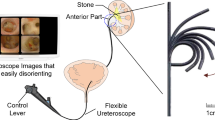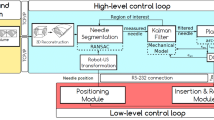Abstract
Concentric tube robot (CTR) is an efficient approach for minimally invasive surgery (MIS) and diagnosis due to its small size and high dexterity. To manipulate the robot accurately and safely inside the human body, tip position and shape information need to be well measured. In this paper, we propose a tip estimation method based on 2D ultrasound images with the help of the forward kinematic model of CTR. The forward kinematic model can help to provide a fast ultrasound scanning path and narrow the region of interest in ultrasound images. For each tube, only three scan positions are needed by combining the kinematic model prediction as prior knowledge. After that, the curve fitting method is used for its shape reconstruction, while its tip position can be estimated based on the constraints of its structure and length.7 This method provides the advantage that only three scan positions are needed for estimating the tip of each telescoping section. Moreover, no structure modification is needed on the robot, which makes it an appropriate approach for existing flexible surgical robots. Experimental results verified the feasibility of the proposed method and the tip estimation error is 0.59 mm.

In this paper, we propose a tip estimation method based on 2D Ultrasound images with the help of the forward kinematic model of CTR. The forward kinematic model can help to provide a fast Ultrasound scanning path and narrow the region of interest in Ultrasound images. For each tube, only three scan positions are needed by combining the kinematic model prediction as prior knowledge. After that, the curve fitting method is used for its shape reconstruction, while its tip position can be estimated based on the constraints of its structure and length.












Similar content being viewed by others
References
Amack S, Rox MF, Emerson M, Webster RJ, Alterovitz R, Kuntz A, Mitchell J, Ertop TE, Gafford J, Maldonado F, Akulian J (2019) Design and control of a compact modular robot for transbronchial lung biopsy. In: Fei B, Linte CA (eds) Medical imaging 2019: image-guided procedures, robotic interventions, and modeling. https://doi.org/10.1117/12.2513967. SPIE
Burgner-Kahrs J, Rucker DC, Choset H (2015) Continuum robots for medical applications: a survey. IEEE Trans Robot 31(6):1261–1280. https://doi.org/10.1109/TRO.2015.2489500
Colleoni E, Moccia S, Du X, De Momi E, Stoyanov D (2019) Deep learning based robotic tool detection and articulation estimation with spatio-temporal layers. IEEE Robot Autom Lett 4 (3):2714–2721. https://doi.org/10.1109/LRA.2019.2917163
Comber DB, Pitt EB, Gilbert HB, Powelson MW, Matijevich E, Neimat JS, Webster RJ, Barth EJ (2017) Optimization of curvilinear needle trajectories for transforamenal hippocampotomy. Oper Neurosurg 13(1):15–21. https://doi.org/10.1227/NEU.0000000000001361
Denasi A, Khan F, Boskma KJ, Kaya M, Hennersperger C, Gobl R, Tirindelli M, Navab N, Misra S (2018) An Observer-Based fusion method using multicore optical shape sensors and ultrasound images for magnetically-actuated catheters. In: Proceedings - IEEE international conference on robotics and automation. https://doi.org/10.1109/ICRA.2018.8462695, pp 50–57
Dupont PE, Lock J, Itkowitz B, Butler E (2010) Design and control of concentric-tube robots. IEEE Trans Robot 26(2):209–225. https://doi.org/10.1109/TRO.2009.2035740
Dupont PE, Gosline A, Vasilyev N, Lock J, Butler E, Folk C, Cohen a Chen R, Schmitz G, Ren H, del Nido P (2012) Concentric tube robots for minimally invasive surgery. In: Hamlyn symposium on medical robotics, pp 3–5
Fagogenis G, Mencattelli M, Machaidze Z, Rosa B, Price K, Wu F, Weixler V, Saeed M, Mayer JE, Dupont PE (2019) Autonomous robotic intracardiac catheter navigation using haptic vision. Sci Robot 4(29). https://doi.org/10.1126/scirobotics.aaw1977
Gafford JB, Webster S, Dillon N, Blum E, Hendrick R, Maldonado F, Gillaspie EA, Rickman OB, Herrell SD, Webster RJ (2020) A concentric tube robot system for rigid bronchoscopy: a feasibility study on central airway obstruction removal. Ann Biomed Eng 48(1):181–191. https://doi.org/10.1007/s10439-019-02325-x
Gilbert HB, Rucker DC, Webster IIIRJ (2016) Concentric tube robots: the state of the art and future directions. In: Springer Tracts in Advanced Robotics, vol 114, pp 253–269
Hongliang Ren, Dupont PE (2011) Tubular structure enhancement for surgical instrument detection in 3D ultrasound. In: 2011 Annual international conference of the ieee engineering in medicine and biology society, vol 23. IEEE, pp 7203–7206. https://doi.org/10.1109/IEMBS.2011.6091820, NIHMS150003
Kuntz A, Sethi A, Webster RJ, Alterovitz R (2020) Learning the complete shape of concentric tube robots. IEEE Trans Med Robot Bion 2(2):140–147. https://doi.org/10.1109/TMRB.2020.2974523
Lasso A, Heffter T, Rankin A, Pinter C, Ungi T, Fichtinger G (2014) PLUS: open-source toolkit for ultrasound-guided intervention systems. IEEE Trans Bio-Med Eng 61 (10):2527–37. https://doi.org/10.1109/TBME.2014.2322864
Li Z, Song S, Liu L, Meng MQ (2019) Tip estimation method in phantoms for curved needle using 2D transverse ultrasound images. Appl Sci (Switzerland) 9(24). https://doi.org/10.3390/app9245305
Liu H, Farvardin A, Grupp R, Murphy RJ, Taylor RH, Iordachita I, Armand M (2015) Shape tracking of a dexterous continuum manipulator utilizing two large deflection shape sensors. IEEE Sensors J 15(10):5494–5503. https://doi.org/10.1109/JSEN.2015.2442266
Lobaton EJ, Fu J, Torres LG, Alterovitz R (2013a) Continuous shape estimation of continuum robots using X-ray images. In: 2013 IEEE international conference on robotics and automation, vol 176. IEEE, pp 725–732. https://doi.org/10.1109/ICRA.2013.6630653
Lobaton EJ, Fu J, Torres LG, Alterovitz R (2013b) Continuous shape estimation of continuum robots using X-ray images. In: 2013 IEEE International conference on robotics and automation, vol 176. IEEE, pp 725–732. https://doi.org/10.1109/ICRA.2013.6630653
Ren H, Vasilyev NV, Dupont PE (2011) Detection of curved robots using 3D ultrasound. In: 2011 IEEE/RSJ international conference on intelligent robots and systems, vol 23. IEEE, pp 2083–2089. https://doi.org/10.1109/IROS.2011.6094915, NIHMS150003
Rucker DC, Webster RJ, Chirikjian GS, Cowan NJ (2010) Equilibrium conformations of concentric-tube continuum robots. Int J Robot Res 29(10):1263–1280. https://doi.org/10.1177/0278364910367543, NIHMS150003
Ryu SC, Dupont PE (2014) FBG-Based shape sensing tubes for continuum robots. In: Proceedings - IEEE international conference on robotics and automation. https://doi.org/10.1109/ICRA.2014.6907368, pp 3531–3537
Shi C, Luo X, Qi P, Li T, Song S, Najdovski Z, Fukuda T, Ren H (2017) Shape sensing techniques for continuum robots in minimally invasive surgery: a survey. IEEE Trans Biomed Eng 64 (8):1665–1678. https://doi.org/10.1109/TBME.2016.2622361
Song S, Li Z, Yu H, Ren H (2015) Electromagnetic positioning for tip tracking and shape sensing of flexible robots. IEEE Sensors J 15(8):4565–4575. https://doi.org/10.1109/JSEN.2015.2424228
Song S, Zhang C, Wang J, Ren H, Meng MQ (2018) Real-time shape estimation of curvilinear flexible surgical robots: methods, experiments and analysis. Int J Robot Autom 33(5):559–568. https://doi.org/10.2316/Journal.206.2018.5.206-5329
Su H, Cardona DC, Shang W, Camilo A, Cole GA, Rucker DC, Webster RJ, Fischer GS (2012) A MRI-guided concentric tube continuum robot with piezoelectric actuation: a feasibility study. In: Proceedings - IEEE international conference on robotics and automation. https://doi.org/10.1109/ICRA.2012.6224550, 15334406, pp 1939–1945
Vandini A, Bergeles C, Fy Lin, Gz Yang (2015) Vision-based intraoperative shape sensing of concentric tube robots. In: 2015 IEEE/RSJ International conference on intelligent robots and systems (IROS). https://doi.org/10.1109/IROS.2015.7353732. IEEE, pp 2603–2610
Vandini A, Bergeles C, Glocker B, Giataganas P, Yang GZ (2017) Unified tracking and shape estimation for concentric tube robots. IEEE Trans Robot 33(4):901–915. https://doi.org/10.1109/TRO.2017.2690977
Waine M, Rossa C, Sloboda R, Usmani N, Tavakoli M (2016) Needle tracking and deflection prediction for Robot-Assisted needle insertion using 2D ultrasound images. J Med Robot Res 01(01):1640001. https://doi.org/10.1142/S2424905X16400018
Wang J, Yang X, Li P, Song S, Liu L, Meng MQ (2020) Design of a multi-arm concentric-tube robot system for transnasal surgery. Med Biol Eng Comput 58(3):497–508. https://doi.org/10.1007/s11517-019-02093-9
Webster RJ, Romano JM, Cowan NJ (2009) Mechanics of precurved-tube continuum robots. IEEE Trans Robot 25(1):67–78. https://doi.org/10.1109/TRO.2008.2006868
Xu R, Yurkewich A, Patel RV (2016a) Curvature, torsion, and force sensing in continuum robots using helically wrapped FBG sensors. IEEE Robot Autom Lett 1(2):1052–1059. https://doi.org/10.1109/LRA.2016.2530867
Xu R, Yurkewich A, Patel RV (2016b) Shape sensing for torsionally compliant concentric-tube robots. In: Gannot I (ed) Optical fibers and sensors for medical diagnostics and treatment applications XVI. https://doi.org/10.1117/12.2213128, vol 9702, p 97020V
Zaffino P, Pernelle G, Mastmeyer A, Mehrtash A, Zhang H, Kikinis R, Kapur T, Francesca Spadea M (2020) Fully automatic catheter segmentation in MRI with 3D convolutional neural networks: application to MRI-guided gynecologic brachytherapy. Phys Med Biol 64(16):165008. https://doi.org/10.1088/1361-6560/ab2f47
Funding
This work was supported in part by National Natural Science Foundation of China (61803123), in part by RGC NSFC/RGC Joint Research Scheme #N_CUHK-448/17, and in part by Natural Science Foundation of Guangdong (2018A -030310565).
Author information
Authors and Affiliations
Corresponding authors
Ethics declarations
Conflict of interest
The authors declare no competing interests.
Additional information
Publisher’s note
Springer Nature remains neutral with regard to jurisdictional claims in published maps and institutional affiliations.
Rights and permissions
About this article
Cite this article
Li, Z., Yang, X., Song, S. et al. Tip estimation approach for concentric tube robots using 2D ultrasound images and kinematic model. Med Biol Eng Comput 59, 1461–1473 (2021). https://doi.org/10.1007/s11517-021-02369-z
Received:
Accepted:
Published:
Issue Date:
DOI: https://doi.org/10.1007/s11517-021-02369-z




